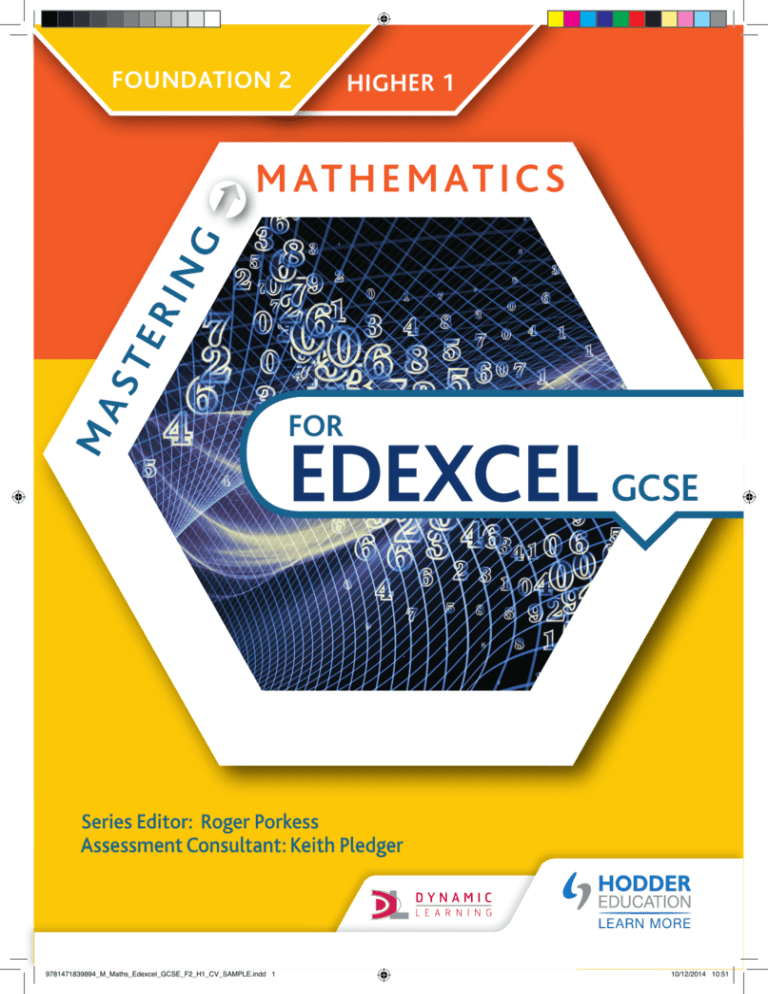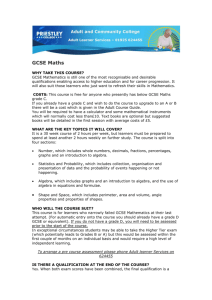
FOUNDATION 2
HIGHER 1
MA
ST
ER
IN
G
M AT H E M AT I C S
FOR
EDEXCEL GCSE
Series Editor: Roger Porkess
Assessment Consultant: Keith Pledger
9781471839894_M_Maths_Edexcel_GCSE_F2_H1_CV_SAMPLE.indd 1
10/12/2014 10:51
Help students to develop their knowledge, skills and understanding enabling them to reason
mathematically, communicate mathematical information and apply mathematical techniques in solving
problems; with resources developed specifically for the Edexcel GCSE 2015 specification with leading
Assessment Consultant Keith Pledger and a team of subject specialists.
We are working with Edexcel to get these resources endorsed:
Mastering Mathematics for Edexcel GCSE Foundation 1
Mastering Mathematics for Edexcel GCSE Foundation 2/ Higher 1
Mastering Mathematics for Edexcel GCSE Higher 2
9781471839818
9781471839894
9781471839948
May 2015
April 2015
June 2015
£17.99
£17.99
£17.99
Our Edexcel resources have been written by an author team experienced in teaching and
examining at GCSE over many years and supported by our Assessment Consultant Keith Pledger,
an experienced examiner and former chair of examiners.
Visit www.hoddereducation.co.uk/Edexcel-GCSE-MasteringMathematics to pre-order
or to sign up for Inspection Copies.
Also available:
Mastering Mathematics 11-16 Dynamic Learning for Edexcel GCSE
Dynamic Learning is an online subscription that supports teachers and students with high quality content and unique
tools. Our Mastering Mathematics Dynamic Learning (11-16 KS3 & GCSE) focuses on strands of learning within the
new National Curriculum to improve progression throughout secondary mathematics, offering a seamless five year
progression.
9781471844706 Prices from £1,040.00 + VAT
Sign up for a free 30 day trial of Dynamic Learning at www.hoddereducation.co.uk/dynamiclearning
9781471839894_M_Maths_Edexcel_GCSE_F2_H1_CV_SAMPLE.indd 2
10/12/2014 10:51
6:22 PM
Contents
NUMBER
Strand 1 Calculating
Units 1–9 Moving on
Strand 2 Using our number system
Units 1–6 Moving on
Unit 7 Calculate with standard form
Strand 3 Accuracy
Units 1–6 Moving on
Unit 7 Limits of accuracy
Strand 4 Fractions
Units 1–6 Moving on
Strand 5 Percentages
Units 1–5 Moving on
Unit 6 Reverse percentages
Unit 7 Repeated percentage increase or decrease
Strand 6 Ratio and proportion
Units 1–3 Moving on
Unit 4 The constant of proportionality
Unit 5 Working with inversely proportional quantities
Strand 7 Number properties
Units 1–3 Moving on
Unit 4 Index notation
Unit 5 Prime factorisation
Unit 6 Roots and integer indices
ALGEBRA
Strand 1 Starting algebra
Units 1–6 Moving on
Unit 7 Working with more complex equations
Unit 8 Solving equations with brackets
Unit 9 Simplifying harder expressions
Unit 10 Using complex formulae
Unit 11 Identities
iii
MM_GCSE_Edx_Higher1.indd 3
09/12/14 6:41 PM
Contents
Strand 2 Sequences
Units 1–4 Moving on
Unit 5 Quadratic sequences
Unit 6 Other types of sequence
Strand 3 Functions and graphs
Units 1–3 Moving on
Unit 4 Plotting quadratic and cubic graphs
Unit 5 Finding equations of lines
Unit 6 Rates of change in context
Unit 7 Recognising and sketching functions
Strand 4 Algebraic methods
Unit 1 Moving on
Unit 2 Linear inequalities
Unit 3 Solve pairs of equations by substitution
Unit 4 Solve simultaneous equations using elimination
Unit 5 Using graphs to solve simultaneous equations
Strand 5 Properties of non-linear graphs
Unit 1 Quadratic functions
Strand 6 Working with quadratics
Unit 1 Factorising quadratics
Unit 2 Solve equations by factorising
GEOMETRY AND MEASURES
Strand 1 Units and scales
Units 1–10 Moving on
Unit 11 Converting compound units
Strand 2 Properties of shapes
Units 1–8 Moving on
Unit 9 Congruent triangles
Unit 10 Conjecture and proof
Strand 3 Measuring shapes
Units 1–4 Moving on
Unit 5 Pythagoras’ theorem
Unit 6 Arcs and sectors
iv
MM_GCSE_Edx_Higher1.indd 4
09/12/14 6:41 PM
Contents
Strand 4 Construction
Units 1–2 Moving on
Unit 3 Construction with a pair of compasses
Unit 4 Loci
Unit 5 Constructing plans and elevations
Strand 5 Transformations
Units 1–5 Moving on
Unit 6 Enlargement
Unit 7 Similarity
Unit 8 Trigonometry
Unit 9 Trigonometry for special angles
Unit 10 Finding centres of rotation
Strand 6 Three-dimensional shapes
Units 1–6 Moving on
Unit 7 Surface area and volume of 3D shapes
Strand 7 Vectors
Unit 1 Vectors
Unit 2 Multiplying by a scalar
STATISTICS AND PROBABILITY
Strand 1 Statistical measures
Units 1–4 Moving on
Strand 2 Statistical diagrams
Units 1–4 Moving on
Unit 5 Displaying grouped data
Unit 6 Scatter graphs
Unit 7 Using lines of best fit
Strand 3 Collecting data
Unit 1 Methods of collecting data
Unit 2 Designing questionnaires
Unit 3 Sampling
Strand 4 Probability
Units 1–3 Moving on
Unit 4 Estimating probability
Unit 5 The addition rule
Unit 6 The multiplication rule
v
MM_GCSE_Edx_Higher1.indd 5
09/12/14 6:41 PM
Acknowlegements
Photo credits:
p. 4 © Getty Images / iStockphoto / Thinkstock; p. 6 © Caitlin Seymour; p. 8 © Jürgen Fälchle – Fotolia
Although every effort has been made to ensure that website addresses are correct at time of going to press,
Hodder Education cannot be held responsible for the content of any website mentioned in this book. It is sometimes
possible to find a relocated web page by typing in the address of the home page for a website in the URL window of
your browser.
Hachette UK’s policy is to use papers that are natural, renewable and recyclable products and made from wood
grown in sustainable forests. The logging and manufacturing processes are expected to conform to the environmental
regulations of the country of origin.
Orders: please contact Bookpoint Ltd, 130 Milton Park, Abingdon, Oxon OX14 4SB. Telephone: +44 (0)1235 827720.
Fax: +44 (0)1235 400454. Lines are open 9.00a.m.–5.00p.m., Monday to Saturday, with a 24-hour message answering
service. Visit our website at www.hoddereducation.co.uk
© Gareth Cole, Heather Davis, Sophie Goldie, Linda Liggett, Robin Liggett, Andrew Manning, Richard Perring, Keith
Pledger, Rob Summerson 2015
First published in 2015 by
Hodder Education,
An Hachette UK Company
338 Euston Road
London NW1 3BH
Impression number
Year
5
4
3
2
1
2019 2018 2017 2016 2015
All rights reserved. Apart from any use permitted under UK copyright law, no part of this publication may be reproduced
or transmitted in any form or by any means, electronic or mechanical, including photocopying and recording, or held
within any information storage and retrieval system, without permission in writing from the publisher or under licence
from the Copyright Licensing Agency Limited. Further details of such licences (for reprographic reproduction) may be
obtained from the Copyright Licensing Agency Limited, Saffron House, 6–10 Kirby Street, London EC1N 8TS.
Cover photo © agsandrew
Illustrations by Integra
Typeset in ITC Avant Garde Gothic Std Book 10/12 by Integra Software Services Pvt. Ltd., Pondicherry, India
Printed in Italy
A catalogue record for this title is available from the British Library
ISBN 9781471839894
vi
MM_GCSE_Edx_Higher1.indd 6
09/12/14 6:41 PM
Strand 2 Using our number system
Unit 1
Band c
Working with whole
numbers
Unit 4
Band e
Unit 2
Band d
Understanding decimals
Unit 3
Band e
Understanding negative
numbers
Multiplying and dividing
decimals by 10, 100, etc.
Unit 5
Unit 6
Band e
Band h
Using the number system
effectively
Understanding standard
form
Foundation 1
Foundation 1
Unit 8
Band i
Unit 7
Band h
Recurring decimals
Calculate with standard
form
Higher 2
Page 4
1
MM_GCSE_Edx_Higher1.indd 1
09/12/14 6:41 PM
2
Unit 7 Calculate with standard
form
Outside the maths classroom
Measuring space
How many stars are there in our galaxy?
Toolbox
Toolbox
Adding or subtracting numbers in standard form is straightforward if the multiple of ten is
the same.
Five million added to three million is eight million, which can be written as
5 × 106 + 3 × 106 = 8 × 106.
If the powers of ten are not equal rewrite them so they are.
Then the same strategy can be used.
6 × 109 + 5 × 108 = 60 × 108 + 5 × 108
making the powers of 10 the same
= 65 × 108
adding
= 6.5 × 109.
rewrite the number in standard form
When multiplying (or dividing) two numbers in standard form, work with each part of
the number separately.
5 × 107 × 3 × 104 = 5 × 3 × 107 × 103
= 15 × 1010
5 × 3 = 15, 107 × 103 = 1010
Note: This is not standard form.
11
= 1.5 × 10
The number must be between 1 and 10.
4
MM_GCSE_Edx_Higher1.indd 4
09/12/14 6:42 PM
Unit 7 Calculate with standard form
Example – Multiplying large and small numbers
A grain of sand weighs around 3.5 × 10−10 kg.
It is thought that there are around 7.5 × 1018 grains of sand on the Earth.
Use the figures above to calculate the weight of all of the sand on Earth. Give your answer in
standard form.
Solution
3.5 × 10−10 × 7.5 × 1018 = 26.25 × 108
3.5 × 7.5 = 36.25, 10
= 2.625 × 109 kg
−10
18
8
× 10 = 10
Make the number between 1 and 10.
Example – Subtraction and division of small numbers
A loaf of bread contains 5 × 10−3 kg of yeast and 1 × 10−2 kg of salt.
a How much do the salt and yeast weigh in total?
b How much greater is the weight of the salt than the yeast in kg?
c How many times is the weight of salt greater than the yeast?
Solution
a 1 × 10−2 + 5 × 10−3 = 10 × 10−3 + 5 × 10−3
= 15 × 10−3 kg
= 1.5 × 10−2 kg
b
c
−2
−3
In standard form.
−3
= 10 × 10 − 5 × 10
= 5 × 10−3 kg
The salt weighs 5 × 10−3 kg more than the yeast.
1 × 10
– 5 × 10
−3
Converting to the same
powers of ten.
weight of salt
1× 10–2
=
weight of yeast 5 × 10–3
= 0.2 × 10−2−(−3)
1
= 0.2 × 10
= 2 (× 100)
There is twice as much salt as yeast.
Do the questions in this unit without a calculator first. Use your calculator to check your answers.
Practising skills
1 Work out the values of the following, giving your answers in standard form.
a 3.2 × 105 + 4.6 × 105
b 6.8 × 10−2 − 5.1 × 10−2
c 8000 + 700
d 6.4 × 103 + 2000
e 1.8 × 10−3 + 2.2 × 10−3
2 Work out the following, giving your answers in standard form.
a 7.2 × 105 + 4.6 × 105
b 7.2 × 105 + 4.6 × 104
d 7.2 × 105 − 4.6 × 105
e 7.2 × 106 − 4.6 × 105
f
6.4 × 10−2 − 0.033
c 7.2 × 105 + 4.6 × 106
f
7.2 × 105 − 4.6 × 106
5
MM_GCSE_Edx_Higher1.indd 5
09/12/14 6:42 PM
Strand 2 Using our number system
3 Without using a calculator work out the value of the following. Give your answers in standard form.
a 3 × 105 × 2 × 107
b 2 × 103 × 4 × 105
c 2 × 105 × 5 × 102
d 3 × 10−5 × 3 × 107
e 5 × 10−7 × 2 × 105
f
9 × 10−6 × 7 × 10−4
4 Without using a calculator work out the value of these calculations.
a 6 × 105 ÷ 2 × 103
b 8 × 109 ÷ 4 × 108
c 6 × 105 ÷ 2 × 103
d 3 × 107 ÷ 2 × 103
e 2 × 105 ÷ 4 × 103
f
2 × 106 ÷ 8 × 108
5 Using standard form, write down a number that is between:
a 6 × 105 and 6 × 104
b 6 × 10−3 and 6 × 10−2
c 7.1 × 102 and 7.1 × 103
d 7.1 × 10−6 and 7.1 × 10−7
6 Coley says:
Reasoning
When you’re multiplying numbers in
standard form you have to multiply the
two numbers at the front together and
write down what that comes to, then
write ‘×10’ and finally add the two
powers together and write that down.
Explain why Coley’s method won’t always give
the correct answer in standard form.
Developing fluency
1 Work out the following, giving your answers in standard form.
a 3.204 × 102 + 4 × 10−1
b 3.204 × 102 − 4 × 10−1
Exam-style
c 3.204 × 102 × 4 × 10−1
d 3.204 × 102 ÷ 4 × 10−1
2 The speed of light is 3 × 108 metres per second and there are roughly 3 × 107 seconds in a year.
A light year is the distance travelled by light in one year.
Approximately how many metres is a light year?
Give your answer in standard form.
3 The masses of some of the planets in our Solar System are:
Jupiter 1.9 × 1027 kg
Mercury 3.3 × 1023 kg
Saturn 5.7 × 1026 kg
Earth 6 × 1024 kg.
a Place the planets in order of mass.
b How many times greater than the mass of the Earth is the mass of Jupiter?
c How many times greater than the mass of Mercury is the mass of Jupiter?
d How many time greater than the mass of Mercury is the mass of the Earth?
6
MM_GCSE_Edx_Higher1.indd 6
09/12/14 6:42 PM
Exam-style
Unit 7 Calculate with standard form
4 Some approximate masses are:
caffeine molecule 3.2 × 10−25 kg
eyebrow hair 7 × 10−8 kg
average human cell 1 × 10−12 kg
water molecule 3 × 10−26 kg.
a How many water molecules weigh the same as an eyebrow hair?
b How many water molecules weigh the same as one caffeine molecule?
c How many times greater than the mass of a water molecule is the mass of an eyebrow hair?
5 A hydrogen atom weighs 1.67 × 10−27 kg.
An oxygen atom weighs 2.67 × 10−26 kg.
What is the mass of a molecule of water?
Problem solving
Exam-style
1 The mass of a spacecraft is 7.8 × 104 kg.
The spacecraft is carrying equipment with a total mass of 2.4 × 103 kg.
The spacecraft docks with a space station.
The mass of the space station is 4.62 × 105 kg.
The commander of the space station does not want the total mass on docking to be greater
than 5.43 × 105 kg.
Is the total mass within this limit?
Exam-style
Exam-style
2 Jenny is making a scale model of the Solar System.
She wants the distance from Earth to Saturn to be 20 cm on her scale model.
The real distance from the Earth to Saturn is 1.25 × 109 kilometres.
a Find the scale of the model in the form 1 : n where n is written in standard form.
Jenny wants to put the position of a spacecraft on the scale model.
The real distance of the spacecraft from Earth is 8.5 × 108 kilometres, correct to 2 significant
figures.
b Work out the distance of the spacecraft from Earth on the scale model.
3 Karim is trying to find out the thickness of a piece of paper.
He has a box of paper which contains 3000 sheets of paper positioned on top of each other.
The height of the paper is 0.3 m.
a Work out the thickness of each sheet of paper.
Give your answer in metres, in standard form.
Karim also wants to know the weight of each sheet of paper.
He weighs the box containing the paper, then he weighs the box when it is empty.
The weight of the box and paper is 54 kg.
The weight of the empty box is 500 g.
b Work out the weight of each piece of paper.
Give your answer in kilograms, in standard form.
7
MM_GCSE_Edx_Higher1.indd 7
09/12/14 6:42 PM
Strand 2 Using our number system
4 Elaine is estimating how far away a thunderstorm is from
her home.
The speed of light is estimated at 3.0 × 108 metres per
second.
a The thunderstorm is 6 km away and Elaine sees a
flash of lightning.
She hears the clap of thunder x seconds later.
Work out the value of x.
Give your answer to the nearest whole number.
Higher tier only
Exam-style
The speed of sound is estimated at 3.3 × 102 metres per
second.
b The length of time between seeing the next flash of
lightning and hearing the clap of thunder is 3 seconds.
How far away is the thunderstorm now?
State any assumptions that you have made.
5 Lynn is carrying out a survey on the living space per person in five different countries.
The table shows the information that she has collected.
Area (in km2)
Population
Australia
3.0 × 106
2.2 × 107
Brazil
8.5 × 106
2.0 × 108
China
9.6 × 106
1.4 × 109
Germany
3.6 × 105
8.3 × 107
UK
2.4 × 105
6.4 × 107
USA
9.8 × 106
3.2 × 108
Area (in km2)
per person
Higher tier only
Exam-style
Country
Exam-style
She wants to find out which country has the greatest land area per person.
Complete the table and compare the five countries.
6 Rod is a keen physicist interested in the wavelengths of sound waves.
Rod wants to find the difference between the wavelength of his favourite radio station to the
wavelength of his dad’s favourite radio station.
Rod listens to FM Capital Radio which has a frequency of 102 MHz.
Rod’s dad listens to AM Radio 5 Live which has a frequency of 909 kHz.
1 MHz = 106 waves per second. 1 kHz = 103 waves per second.
To find the wavelength (in m), Rod uses the formula:
wavelength = 3 × 108 ÷ frequency (in waves per second)
Work out the difference between the wavelength of Rod’s favourite radio station and the
wavelength of his dad’s favourite radio station.
8
MM_GCSE_Edx_Higher1.indd 8
09/12/14 6:42 PM
Unit 7 Calculate with standard form
Reviewing skills
1 Work out
a 8.48 × 104 + 8.4 × 103 − 3 × 102
Give your answer in standard form.
b Write the following as ordinary numbers.
i
8.48 × 104
ii 8.4 × 103
iii 3 × 102
c Use your answers to part b to check your answer to part a.
2 Work out the following, giving your answers in standard form.
a 6000 × 1.5 × 109
b 1.6 × 10−4 × 2 × 10−3
d 0.0052 − 3.2 × 10−3
e 7.6 × 102 × 2 × 10−1
c 2.3 × 106 + 3 million
f
7.6 × 102 ÷ 2 × 10−1
3 A human body contains roughly 1 × 1012 bacteria and there are about 7 × 109 people on
the planet.
How many bacteria are there in total within all of the people?
9
MM_GCSE_Edx_Higher1.indd 9
09/12/14 6:42 PM
This book is supported by Dynamic Learning – the online subscription service that helps
make teaching and learning easier.
Dynamic Learning supports teachers and students with high quality content and unique tools. Dynamic
Learning incorporates elements that all work together to give you the ultimate classroom and homework
resource.
Teaching and Learning titles include interactive resources, lesson planning tools, self-marking tests
and assessment. Teachers can:
● use the Lesson Builder to plan and deliver outstanding lessons
● share lessons and resources with students and colleagues
● track students progress with Tests and Assessments
Teachers can also combine their own trusted resources alongside those from Mastering Mathematics
for Edexcel GCSE which has a whole host of informative and interactive resources including:
● hundreds of activities, exam-style questions and worked solutions
● online questions for each topic that can be set as homework and are automatically marked
● classroom-ready teaching and learning resources that focus on the new assessment objectives and
are organised by topic, allowing you to use them alongside any Scheme of Work
Mastering Mathematics for Edexcel GCSE is available as a Whiteboard eTextbook which is an
online interactive version of the printed textbook that enable teachers to:
● display interactive pages to their class
● add notes and highlight areas
● add double-page spreads into lesson plans
Additionally the Student eTextbook of Mastering Mathematics for Edexcel GCSE is a downloadable
version of the printed textbook that teachers can assign to students so they can:
● download and view on any device or browser
● add, edit and synchronise notes across two devices
● access their personal copy on the move
To find out more and sign up for free trials visit: www.hoddereducation.co.uk/dynamiclearning
9781471839894_M_Maths_Edexcel_GCSE_F2_H1_CV_SAMPLE.indd 3
10/12/2014 10:51
This sample chapter is taken from
Mastering Mathematics for Edexcel GCSE
Foundation 2/ Higher 1
M AT H E M AT I C S
MA
ST
ER
IN
G
Help students to develop their
knowledge, skills and understanding
so that they can reason mathematically,
communicate mathematical information
and apply mathematical techniques in solving
problems; with resources developed specifically for the
Edexcel GCSE 2015 specification with leading Assessment
Consultant Keith Pledger and a team of subject specialists.
Supports you and your students through the new specifications,
with topic explanations and new exam-style questions
Builds understanding and measures progress with plenty of graduated
exercises and worked examples
Organises topics into progression strands, enabling you and your students
to identify gaps in learning and apply appropriate remediation or
extension steps in order to make the best progress.
Series Editor:
Roger Porkess is a highly experienced author who held the
position of MEI Chief Executive for 20 years.
Assessment consultant:
Keith Pledger was formerly a senior examiner and
is an experienced and high-selling author with
over a million books sold.
First teaching
from
September
2015
ALSO AVAILABLE
Dynamic Learning
This book is supported by Dynamic Learning – the online subscription
service that helps make teaching and learning easier.
Dynamic Learning provides unique tools and content for:
● front-of-class teaching
● streamlining planning and sharing lessons
● focused and flexible assessment preparation
● independent, flexible student study
Textbook subject to
change based on
Ofqual feedback
Sign up for a free 30 day trial – visit: www.hoddereducation.co.uk/dynamiclearning
9781471839894_M_Maths_Edexcel_GCSE_F2_H1_CV_SAMPLE.indd 4
10/12/2014 10:51









